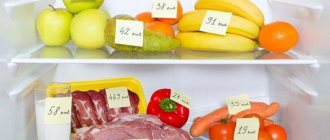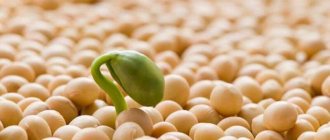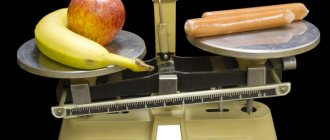Glycogen is a “reserve” carbohydrate in the human body, belonging to the class of polysaccharides.
It is sometimes mistakenly called "glucagon". It is important not to confuse both names, since the second term is a protein hormone that indirectly, through specific glucagon receptors in the liver, causes increased catabolism of glycogen deposited in the liver, i.e. serves as an external signal for hepatocytes (liver cells) to release glucose into the blood due to the breakdown of glycogen (glycogenolysis) or the synthesis of glucose from other substances (gluconeogenesis). It causes an increase in insulin secretion from healthy pancreatic cells.
Where are stocks stored?
Content:
- What is glycogen?
- Where are stocks stored?
- Biochemical properties
- The role of glycogen
- Synthesizing
- Glycogenosis and other disorders
- The body's need for glycogen
- Food for glycogen storage
- Effect of glycogen on body weight
- Deficit and surplus: how to determine
Glycogen reserves in the form of tiny granules are stored in the liver and muscle tissue. This polysaccharide is also found in the cells of the nervous system, kidneys, aorta, epithelium, brain, embryonic tissues and the mucous membrane of the uterus. The body of a healthy adult usually contains about 400 g of the substance. But, by the way, during increased physical activity the body predominantly uses glycogen from muscles. Therefore, bodybuilders should additionally saturate themselves with high-carbohydrate foods approximately 2 hours before training in order to restore their reserves of the substance.
Dependence of fat burning on glycogen
For an hour of physical aerobic and anaerobic activity, the body requires about 100-150 grams of glycogen. When the available reserves of this substance are exhausted, a sequence enters into a reaction involving the destruction of first muscle fibers and then adipose tissue.
To get rid of excess fat, it is most effective to exercise after a long break since your last meal, when glycogen stores are depleted, for example, on an empty stomach in the morning. You need to train at an average pace to lose weight.
Biochemical properties
Chemists call a polysaccharide with the formula (C6H10O5)n glycogen. Another name for this substance is animal starch. And although glycogen is stored in animal cells, this name is not entirely correct. The substance was discovered by the French physiologist Bernard. Almost 160 years ago, a scientist first discovered “spare” carbohydrates in liver cells.
“Spare” carbohydrate is stored in the cytoplasm of cells. But if the body experiences a sudden lack of glucose, glycogen is released and enters the blood. But, interestingly, only the polysaccharide accumulated in liver cells (hepatocytes) can transform into glucose, which can saturate a “hungry” body. Glycogen reserves in it can reach 5% of its mass, and in an adult body be about 100-120 g. Glycogen in hepatocytes reaches its maximum concentration approximately an hour and a half after a meal rich in carbohydrates (confectionery, flour, starchy foods).
In muscle composition, the polysaccharide occupies no more than 1-2% of the tissue mass. But, taking into account the total muscle mass, it becomes clear that the glycogen “deposits” in the muscles exceed the reserves of the substance in the liver. There are also small reserves of carbohydrate in the kidneys, glial cells of the brain and leukocytes (white blood cells). Thus, the total glycogen reserves in an adult body can amount to almost half a kilogram.
Interestingly, the “spare” polysaccharide is found in the cells of some plants, fungi (yeast) and bacteria.
The role of glycogen
Glycogen is mainly concentrated in liver and muscle cells. And it should be understood that these two sources of reserve energy have different functions. Polysaccharide from the liver supplies glucose to the body as a whole. That is, it is responsible for the stability of blood sugar levels. With excessive activity or between meals, plasma glucose levels decrease. And in order to avoid hypoglycemia, glycogen contained in liver cells is broken down and enters the bloodstream, leveling the glucose level. The regulatory function of the liver in this regard cannot be underestimated, since a change in sugar levels in any direction is fraught with serious problems, even death.
Muscle reserves are necessary to maintain the functioning of the musculoskeletal system. The heart is also a muscle that stores glycogen. Knowing this, it becomes clear why most people develop heart problems after prolonged fasting or with anorexia.
But if excess glucose can be stored in the form of glycogen, then the question arises: “Why are carbohydrate foods stored on the body as fat?” There is also an explanation for this. Glycogen reserves in the body are not dimensionless. With low physical activity, animal starch reserves do not have time to be used up, so glucose accumulates in another form - in the form of lipids under the skin.
In addition, glycogen is necessary for the catabolism of complex carbohydrates and participates in metabolic processes in the body.
Signs and Causes of Low Glycogen Levels
A low level of polysaccharides in the body will be expressed in rapid fatigue during physical exercise and mental work. A diet rich in carbohydrates and rest will help solve this problem.
Metabolic diseases also occur - glycogenosis, 1 case per 100-500 thousand newborns. These metabolic disorders are caused by a deficiency of enzymes that affect glycogen synthesis in muscles and liver cells. They manifest themselves in the form of rapid muscle fatigue, cramps during sports, and even myopathy (damage to muscles and nerves).
Synthesizing
Glycogen is a strategic reserve of energy that is synthesized in the body from carbohydrates.
First, the body uses the carbohydrates received for strategic purposes, and stores the remainder “for a rainy day.” Energy deficiency is the reason for the breakdown of glycogen into the state of glucose.
The synthesis of the substance is regulated by hormones and the nervous system. This process, particularly in the muscles, is “triggered” by adrenaline. And the breakdown of animal starch in the liver activates the hormone glucagon (produced by the pancreas during fasting). The hormone insulin is responsible for the synthesis of “reserve” carbohydrates. The process consists of several stages and occurs exclusively during meals.
Glycogenosis and other disorders
But in some cases, glycogen breakdown does not occur. As a result, glycogen accumulates in the cells of all organs and tissues. Typically, such a disorder is observed in people with genetic disorders (dysfunction of the enzymes necessary to break down the substance). This condition is called glycogenosis and is included in the list of autosomal recessive pathologies. Today, 12 types of this disease are known in medicine, but so far only half of them have been sufficiently studied.
But this is not the only pathology associated with animal starch. Glycogen diseases also include aglycogenosis, a disorder accompanied by a complete absence of the enzyme responsible for glycogen synthesis. Symptoms of the disease are pronounced hypoglycemia and convulsions. The presence of aglycogenosis is determined by liver biopsy.
The body's need for glycogen
Glycogen, as a reserve source of energy, is important to restore regularly. So, at least, scientists say. Increased physical activity can lead to a total depletion of carbohydrate reserves in the liver and muscles, which will ultimately affect a person’s vital activity and performance. As a result of a long-term carbohydrate-free diet, glycogen reserves in the liver are reduced to almost zero. Muscle reserves are depleted during intense strength training.
The minimum daily dose of glycogen is 100 g and above. But it is important to increase this figure when:
- intense physical activity;
- increased mental activity;
- after “starvation” diets.
On the contrary, people with liver dysfunction and enzyme deficiency should be careful about foods rich in carbohydrates.
Migraine
Migraine is a paroxysmal condition manifested by attacks of pulsating headaches in one half of the head, mainly in the orbital-frontotemporal region, or bilateral localization.
The attack is accompanied by nausea, vomiting, photo- and phonophobia. Characterized by recurrence and hereditary predisposition. Migraine affects 12 - 15% of the population. It is the second most common type of primary headache after tension headache. Women experience migraine attacks 2 to 3 times more often than men. The peak incidence occurs between 25 and 34 years of age. There is a hereditary predisposition.
There are two main forms of migraine: migraine without aura (simple migraine) and migraine with aura (associated migraine). Migraine without aura is manifested by attacks of pain that meet the listed criteria. This is the most common form, observed in 80% of cases. In migraine with aura, the pain attack is preceded by a migraine aura.
The criteria for diagnosing migraine were defined by the International Headache Society in 1988: paroxysmal headache lasting from 4 to 72 hours. Headache has at least two of the following characteristics: predominantly unilateral localization, alternating sides, less often bilateral; pulsating character; moderate to severe headache intensity (interferes with daily activities); increased during physical activity; the presence of at least one accompanying symptom – nausea, vomiting, phonophobia, photophobia.
To make a diagnosis of migraine without aura, there must be a history of at least 5 attacks that meet the listed criteria. For migraine with aura, there must be at least 2 attacks that meet these criteria.
The pathogenesis of migraine is complex. The special role of serotonin in migraine is known. Before an attack, platelet aggregation increases, serotonin is released from them, which leads to narrowing of large arteries and veins and dilation of capillaries (at this time, aura symptoms may develop). Subsequently, due to the intensive release of serotonin by the kidneys, its content in the blood decreases, which, together with other factors, causes dilatation and atony of blood vessels (the appearance of throbbing pain).
Complications of migraine include status migraine and migraine stroke. Migraine treatment consists of stopping the attack and preventive treatment in the inter-attack period. To relieve an attack, the following are used: non-steroidal anti-inflammatory drugs, as well as their combination with caffeine or codeine; dihydroergotamine preparations, which have a powerful vasoconstrictor effect; selective serotonin agonists (zolmitriptan, sumatriptan).
For preventive therapy, non-drug methods are used, as well as various pharmacological agents. Drug preventive treatment of migraine includes drugs of various pharmacological groups, which are individually selected for each patient taking into account provoking factors (beta blockers, calcium antagonists, antidepressants, small doses of ASA, antihistamines and muscle relaxants).
Effect of glycogen on body weight
Scientists have determined that about 400 grams of glycogen can accumulate in an adult body. But scientists also determined that each gram of reserve glucose binds approximately 4 grams of water. So it turns out that 400 g of polysaccharide is approximately 2 kg of glycogen aqueous solution. This explains profuse sweating during exercise: the body uses up glycogen and at the same time loses 4 times more fluid.
This property of glycogen also explains the quick results of express diets for weight loss. Low-carbohydrate diets provoke intensive consumption of glycogen, and with it fluids from the body. One liter of water, as you know, is 1 kg of weight. But as soon as a person returns to a normal diet containing carbohydrates, animal starch reserves are restored, and with them the liquid lost during the diet. This is the reason for the short-term results of express weight loss.
For truly effective weight loss, doctors advise not only to revise your diet (give preference to proteins), but also to increase physical activity, which leads to rapid consumption of glycogen. By the way, researchers have calculated that 2-8 minutes of intense cardio training is enough to use glycogen stores and lose excess weight. But this formula is suitable only for people who do not have cardiac problems.
How long does it take to spend?
- What fruits can you eat while losing weight?
- How many minutes of training will it take for fat to burn?
- One is tasty, the other is healthy: 2000 kcal diets with BJU
[Total votes: 5 Average: 5/5]
Bone Wide
This article was reviewed by a certified nutritionist who has a bachelor's degree in nutrition and dietetics, D. G. Veremeev.
Articles are for informational and educational purposes only and are not a substitute for professional medical advice, diagnosis, or treatment. Always consult your physician with any questions you may have about a medical condition.











